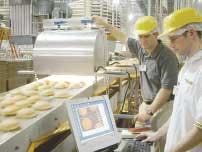Researchers at the Georgia Institute of Technology (Georgia Tech; Atlanta, GA) are working with a local bakery to develop a machine-vision system to automatically inspect freshly baked sandwich buns.
Georgia's food-processing industry is the state's second-largest employer. The project is funded in part by a ten-year-old research and development program—the Traditional Industries Program for Food Processing—focused on boosting that industry's market competitiveness. A major focus of the project is to apply digital-imaging technology to large-scale production of sandwich buns for fast-food restaurants.
In the initial phase of the two-phase project, a digital camera will continually scan passing buns on a production line, enabling an image-processing system to evaluate criteria such as color, shape, size, and seed distribution. Buns that fail the digital inspection process will then be automatically removed from the conveyer belt.
Georgia Tech research engineer Doug Britton and co-op student Daniel Sims observe operation of a prototype continuous-imaging, food-inspection system at Flowers Bakery.
The phase-one laboratory-scale system consists of two IEEE 1394 (a high-speed, low-cost serial bus) CCD cameras, an image-processing computer, and an associated imaging dome (which includes fluorescent lighting). The image-processing software was developed at Georgia Tech. The cameras cover a 26-in. belt and acquire images of up to 1000 buns per minute for processing (see figure). The system interfaces with a standard database for archiving the results for future analysis.
Real-life appraisal
That system, including image-processing algorithms and software to interface with a database archive, has been tested in limited field trials in the Flowers Bakery (Villa Rica, GA). The researchers are currently building a system that can be left on the production line for long-term testing and analysis. They anticipate having it online by the end of this month with full-fledged operational testing to commence immediately thereafter.
"The use of these IEEE-1394 color cameras, the nondependence on a specific conveyor system for the product, and the algorithmic approach are all unique," said Douglas Britton, a Georgia Tech research engineer and co-principal investigator for the project. "This system can be added to almost any conveyor system (either a belt system or wire cooking-rack system). The ability to interface with an existing database system is very powerful for long-term quality tracking and analysis."
In the second phase of the project, data from the screening and image-processing phase will be used to build a supervisory control system to automatically adjust, in real time, the heat- and humidity-controlled chambers (proofers and ovens) where the actual preparation (rising and baking) of dough takes place.
"Despite all the research that has occurred to date, the supervisory controls phase of the project that seeks to automatically adjust the oven is still very much under development," Britton said.
The completed system is intended to save time and money by increasing yield and reducing waste. "There are a number of food products that are partially fried or baked and then frozen for delivery to the end consumer or preparer," Britton said. "The development of an overline imaging system to do quality analysis in baked buns could be very useful in these other environments as well."
The entire project is a collaborative effort including the Georgia Tech Electrical and Computer Engineering School, the Food Processing Technology Division of Georgia Tech's Research Institute, Flowers Bakery, and BakeTech (Tucker, GA), a baking-equipment manufacturer.
"Baking is both a science and an art," said Bonnie Heck, co-principal investigator from the school of Electrical and Computer Engineering. "Good bakers know both and are able to react based on experience and feedback from the process. We're trying to enhance the ability of expert and novice bakers alike to make better quality-control adjustments, while also adding automation that can mimic some of those adjustments dynamically."
